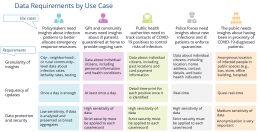European governments are investing in contact tracing technology to accelerate the move to phase 2 of the COVID-19 crisis. As the economic impact of the lockdown mounts, European governments are scrambling to reopen their economies. But reopening will require a delicate balancing act — to enable as much economic activity as possible without causing a second major outbreak.
Based on the experience from East Asia, the speed at which governments are be able to track and trace new cases and their contacts and enforce targeted quarantine measures is paramount. This, along with the implementation of other WHO guidelines, such as widespread testing and reorganization of treatment capabilities, will be key for success — and this will determine not only the death toll, but the feasibility of long-term economic renewal as well.
Contact Tracing Use Cases and Capabilities
European governments need to adopt a number of new use cases linked to contact tracing — and they need to do it fast:
- Tracking of contacts by public health authorities.
- Providing information to the public on outbreaks and the need for testing.
- Tracking of quarantine adherence.
- Tracking of home-based diagnosed patients to ensure proper care.
- Strategic overview dashboards and data insights for policymakers.
All these use cases will require agility in terms of data management, and they will test governments’ commitment to data protection and governance capability in general. Governments will need to abandon their usual cautious approach to the introduction of new technologies and act with a speed that has never been seen in peace time.

Governments will face a number of challenges, from orchestration of multidisciplinary ad hoc teams to persuading the public that their data is safe. They will quickly need to adjust their enterprise architectures to enable the agile implementation of emergency COVID-related solutions.
They will also need to make sure that their employees are trained and ready to use the data tools at their disposal. While doing all this, governments will look at the examples of best (and not-so-best) practices abroad — tweaking their own processes to mirror what has worked elsewhere and avoid errors made in other countries.
Acting Fast and Informing the Public
While it’s still too early to tell which European countries are adopting the most efficient track-and-trace strategies, they face similar challenges and pathways. This is why it’s necessary in the early stages to design track-and-trace policies to ensure that they can be quickly readjusted if needed.
Data solutions will be at the core of this.
With properly designed information flows, first-line workers can focus on their job rather than on making sure they’re not putting themselves and others in harm’s way through lack of information. Policymakers can focus on bringing in innovative solutions instead of expending time just to make sure they’re not flying blind.
Last but not least, the general public, with the right information, can minimize the threat of contagion and keep morale high to ensure compliance with social distancing measures.
For more information and guidance on digital contact tracing and the value it can bring to tackling COVID-19, please see IDC’s Implementation Guide for the European Public Sector — Preparing for COVID-19 Phase 2: Adopting Contact Tracing. The guide elaborates on data and system requirements, solution architecture sourcing options, and data usage practices for each of the five key use cases.
